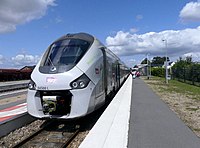
Photo from wikipedia
This study aims to optimize the calorific value with different fuel properties derived from two peat reserved areas. A total of 60 peat samples were evaluated using proximate analysis (moisture… Click to show full abstract
This study aims to optimize the calorific value with different fuel properties derived from two peat reserved areas. A total of 60 peat samples were evaluated using proximate analysis (moisture content, volatile matter, fixed carbon, and ash content) of two separate studied areas. A quadratic polynomial of response surface methodology was applied to the entire set of subsequently studied results. Several analytical equations were used in linear and nonlinear terms to estimate the higher calorific value. Peat samples at Terokhada Upazila show a higher calorific value of 7.050 kcal kg−1, whereas the calorific value of peat sample at Bil Baghia in Madaripur found 5.800 kcal kg−1. The optimal calorific value of peat in both studied areas is 7.05–11.05 kcal kg−1 in Terokhada Upazila and 3.156–7.187 kcal kg−1 in Bil Baghia, Madaripur, respectively. Terokhada Upazila and Bil Baghia, Madaripur, exhibit analytical values of squares regression of (0.0068–0.1245) and (0.003–0.091), respectively. In addition, the standard deviations are found to be between 1.049 and 4.505 kcal kg−1 for Terokhada Upazila peat and between 0.1741 and 2.741 kcal kg1 for Bil Baghia, Madaripur peat, respectively. The RSM quadratic polynomial represents the optimization, and the coded equations are built for two research areas to precisely estimate the highest calorific value. These peats could be helpful to fuel sources if gasified or co-burned with other fuel resources to generate energy. Peat with a higher calorific value can be used as an energy source in the Bangladesh energy sector and globally.
Journal Title: Biomass Conversion and Biorefinery
Year Published: 2021
Link to full text (if available)
Share on Social Media: Sign Up to like & get
recommendations!